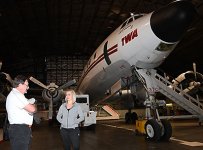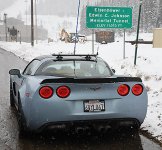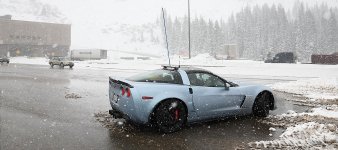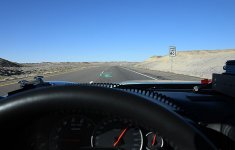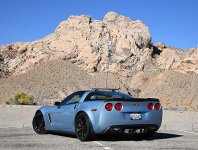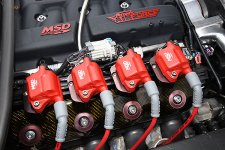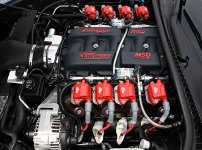- Thread starter
- #361
Hib Halverson
Technical Writer for Internet & Print Media
I have the report from Katech. It came as a .pdf and has "Katech Confidential" displayed on every page, so I can't post the specifics, but I can summarize parts of it.
In mid-May, just before I shipped the car back there, I ran an oil use test lasting about 300 miles. I put a quart in 200-mi after the test started and then another quart at about 100-mi after that. Katech confirmed that level of oil use just prior to their teardown with a road test of their own which showed about 100 miles per quart.
Katech ran the car on the chassis dyno and found it down on power. They put the original calibration back in the ECM and some of the power loss came back, but it was still 50-hp down from what it was when the car left Katech last on 7DEC2017. They also noted the engine exhibited knock retard.
The report states the MAF and spark table calibrations which were problematic. Starting on 28FEB2018, after Katech emailed me that they were unable to continue to send me revised calibration files, I made changes to both those tables. Prior to that, starting in early January, I had, also, made calibration changes, but none were with MAF or spark. Any calibration change voids the warranty Katech extends to Street Attack LS7 customers.
They ran an exhaust pressure test and found excessive back-pressure on both sides. Both cats are restricted. They borescoped one of them and observed spots where the substrate had begun to melt, an indication the air:fuel ratio was lean under high load. No oil residue was observed.
After getting the engine apart, Katech found the crankshaft, bearings, connecting rods and the valve train are all in good condition.
The crosshatch in all bores is just about worn away leaving a near-mirror finish. Bore wear is about .001-in. on all cylinders. All the piston tops were wet with oil. All the rings were severely worn. The Katech guys told me that an air:fuel ratio under load which is excessively lean or excessively rich can cause that type of bore and ring failure. Poor air filtering can, also, cause that level of wear.
Combustion chambers and valve faces are wet with oil and sooty.
The Intake manifold had dirt/debris inside. The air filter had been damaged, by my blowing through it with shop air when I cleaned the filter about a month before shipping the car to Katech. In talking with them and the filter vendor, I found out doing that to oiled-cotton filters is a bad thing.
Katech uses GM's warranty benchmark for excessive oil use which, in brief, states that oil use by engines subjected to "normal" duty cycles more 2000-miles-per-quart indicates an engine mechanical problem.
My "Street Attack LS7" has 4873 miles on it since it was built by Katech in late 2017. In the first 3021 miles of operation, before I violated Katech's warranty by making calibration changes in early January, the engine used two quarts of oil. From then on, oil use accelerated until I shipped the car back to Katech in mid-May.
In a conference call I had early last week with Katech's top managers, they were unable to explain how the oil use got started in the first 3000 miles. Katech's guys said that they have built many Street Attack engines in the last 12 years and have never had an engine with a problem like that.
The next step is for Katech to send me a quote on what's necessary to repair the engine and what it will cost to do that.
Stay tuned....
In mid-May, just before I shipped the car back there, I ran an oil use test lasting about 300 miles. I put a quart in 200-mi after the test started and then another quart at about 100-mi after that. Katech confirmed that level of oil use just prior to their teardown with a road test of their own which showed about 100 miles per quart.
Katech ran the car on the chassis dyno and found it down on power. They put the original calibration back in the ECM and some of the power loss came back, but it was still 50-hp down from what it was when the car left Katech last on 7DEC2017. They also noted the engine exhibited knock retard.
The report states the MAF and spark table calibrations which were problematic. Starting on 28FEB2018, after Katech emailed me that they were unable to continue to send me revised calibration files, I made changes to both those tables. Prior to that, starting in early January, I had, also, made calibration changes, but none were with MAF or spark. Any calibration change voids the warranty Katech extends to Street Attack LS7 customers.
They ran an exhaust pressure test and found excessive back-pressure on both sides. Both cats are restricted. They borescoped one of them and observed spots where the substrate had begun to melt, an indication the air:fuel ratio was lean under high load. No oil residue was observed.
After getting the engine apart, Katech found the crankshaft, bearings, connecting rods and the valve train are all in good condition.
The crosshatch in all bores is just about worn away leaving a near-mirror finish. Bore wear is about .001-in. on all cylinders. All the piston tops were wet with oil. All the rings were severely worn. The Katech guys told me that an air:fuel ratio under load which is excessively lean or excessively rich can cause that type of bore and ring failure. Poor air filtering can, also, cause that level of wear.
Combustion chambers and valve faces are wet with oil and sooty.
The Intake manifold had dirt/debris inside. The air filter had been damaged, by my blowing through it with shop air when I cleaned the filter about a month before shipping the car to Katech. In talking with them and the filter vendor, I found out doing that to oiled-cotton filters is a bad thing.
Katech uses GM's warranty benchmark for excessive oil use which, in brief, states that oil use by engines subjected to "normal" duty cycles more 2000-miles-per-quart indicates an engine mechanical problem.
My "Street Attack LS7" has 4873 miles on it since it was built by Katech in late 2017. In the first 3021 miles of operation, before I violated Katech's warranty by making calibration changes in early January, the engine used two quarts of oil. From then on, oil use accelerated until I shipped the car back to Katech in mid-May.
In a conference call I had early last week with Katech's top managers, they were unable to explain how the oil use got started in the first 3000 miles. Katech's guys said that they have built many Street Attack engines in the last 12 years and have never had an engine with a problem like that.
The next step is for Katech to send me a quote on what's necessary to repair the engine and what it will cost to do that.
Stay tuned....

